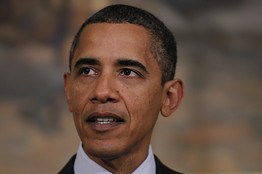The Democratic Fisc
The White House budget office offers a scorecard on Obamanomics.
WSJ.com
Democrats have been running Congress for nearly four years, and President Obama has been at the White House for 18 months, so it's not too soon to ask: How's that working out? One devastating scorecard came out Friday from the White House, in the form of its own semi-annual budget review.
The message: Tax revenues are smaller, spending is greater, and the deficits are thus larger than the White House has been saying. No wonder it dumped the news on the eve of a sweltering mid-July weekend.
Mr. Obama inherited a recession, so let's give him a pass on the budget numbers for 2009. Clearly the deficit would have been large no matter who was President, even if the David Obey-Nancy Pelosi $862 billion stimulus made it larger than it otherwise would have been. What's striking about the latest budget estimates, however, is that the White House is predicting the numbers won't improve much through 2011, the third year of the President's term.
As a share of the economy, the White House now says the deficit in fiscal 2010, which ends on September 30, will be even larger than in 2009: 10%. That's after a full year of economic growth, given that the recovery began last summer. More remarkable still, the deficit will barely fall in fiscal 2011, declining only to 9.2% of GDP in the second year of a recovery that ought to be gaining steam.
![[1omb]](../../images/ED-AL925_1omb_NS_20100725190902.gif)
To put this in historical context, consider the nearby table that compares deficits as a share of GDP under Presidents Reagan and Obama. The 1981-82 recession was comparable in severity to the one Mr. Obama inherited and reached similar heights of unemployment. The deficits that resulted from that recession were the source of huge political consternation, with Democrats, the press corps and even some senior Reagan aides insisting that only a huge tax increase could save the country from ruin.
Yet as the table shows, the Reagan deficits never reached more than 6% of GDP, and that happened only in 1983, the first year of economic recovery. As the 1980s expansion continued, the deficits fell, especially as the pace of spending slowed in the latter part of Reagan's second term. Few remember now, but when Ross Perot won 19% of the Presidential vote in 1992 running more or less on the single issue of the deficit, the budget hole was only 4.7% of GDP.
The Obama deficits are double that, and more than one-third higher than even the Gipper's worst year. What explains this? Part of it is that Democrats are simply spending much more, sending outlays as a share of GDP above 25% for the first time since World War II. The White House now says outlays will be higher in 2011, at 25.1% of GDP, than at the height of the stimulus in 2009 and 2010.
This is an ironic tribute to the degree to which Democrats on Capitol Hill have been increasing spending willy-nilly below the media radar. The 111th Congress is the most spendthrift in a century outside of World Wars I and II.
The other explanation for the record Obama deficits is that revenues have been so anemic, thanks to the lackluster economic recovery. In the Reagan years, revenues as a share of GDP never fell lower than 17.3%, despite (or we would say because of) his pro-growth tax cuts. In 2010, by contrast, the White House now says tax revenues will hit an astonishing low of 14.5% of GDP, rising only to 15.8% in 2011, even with the huge tax increase that hits on January 1, 2011.
The White House predicts revenues will rise sharply after that, as it also assumes the economy will grow by more than 4% in each of 2012, 2013 and 2014. The last time the economy grew that rapidly for that long, however, was from 1997-2000 and from 1983-1985. In both of those cases, taxes were falling. The Obama White House plans a huge tax increase next year, followed by the ObamaCare tax hikes that hit in 2013, and that's before whatever else the President's deficit commission recommends.
Democrats and their defenders will argue that the nature of the 2008-2009 recession, with its roots in financial panic, is the reason for the slow recovery. But it's also true that deep recessions have historically been followed by more robust recoveries.
The point we would stress is that there has also been a notable policy difference between the 1980s and today. The Reagan Administration also pursued fiscal stimulus, but its policy choice was permanent across-the-board cuts in marginal tax rates. Revenue didn't fall nearly as much as Keynesian economists predicted it would, and the economy roared back. Growth and spending restraint then reduced the deficit over time.
Democrats by contrast have pursued stimulus by spending and temporary tax rebates for selective constituencies. They did so first in concert with President George W. Bush, who was intellectually and politically tapped out, in February 2008. Then they did so again, on hyperdrive, with the February 2009 stimulus. They are now doing it again on a smaller scale with another burst of jobless benefits, adding some $30 billion to the deficit.
To put it another way, Democrats have been undertaking a vast fiscal policy
experiment, blowing out the federal balance sheet in an effort to show that a
country can spend and tax its way to prosperity. Look no further than the
numbers in the White House's own budget review for the unhappy lab results.
